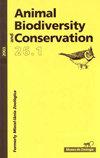河岸森林完整性如何影响无尾猿物种组成:巴西南部大西洋森林的案例研究
IF 1
4区 环境科学与生态学
Q3 BIODIVERSITY CONSERVATION
引用次数: 3
摘要
在巴西,河岸森林受到法律保护,提供重要的生态系统服务,但历史上由于森林砍伐而退化和减少。因此,这些河岸森林和相关生态系统的动物群可能受到强烈影响,就像两栖动物一样。在这项研究中,我们确定了不同环境完整性水平的河岸森林中无尾猿物种组成的变化。这项研究在弗里茨·普劳曼州立公园(FPSP)进行,这是一个具有典型南大西洋森林结构的保护区。我们的结果表明,采样地点的环境完整性影响了每个物种被发现的地方。保存最完好的栖息地,有大面积的河岸森林和较少的人为影响,促进了更大的物种多样性,并允许维持具有特定环境要求的物种。两种已登记的两栖动物(Boana curupi和Vitreorana uranoscopa)被列入濒危两栖动物名单,一种是外来入侵物种(Lithobates catesbeianus)。由于它捕食本地两栖动物并可能作为病原体载体,因此对公园内的本地两栖动物种群构成潜在威胁。尽管FPSP的大部分地区由处于演替次级阶段的森林组成,但与原始森林保存较好的地区的联系允许通常与保存良好的栖息地相关的更需要的物种的普遍出现。在区域层面上,这些栖息地只出现在公园内,如果没有它们,这些物种很可能会在当地或区域灭绝。本文章由计算机程序翻译,如有差异,请以英文原文为准。
How riparian forest integrity influences anuran species composition: a case study in the Southern Brazil Atlantic Forest
Riparian forests are under legal protection in Brazil and provide essential ecosystem services yet have been historically degraded and reduced by deforestation. Consequently, the fauna of these riparian forests and associated ecosystems can be strongly affected, as is the case with amphibians. In this study we identify how anuran species composition varies in riparian forests with various levels of environmental integrity. The study took place in the Fritz Plaumann State Park (FPSP), a protected area with forest formations typical of the Southern Atlantic Forest. Our results suggest that the environmental integrity of the sampling sites influenced where each species was found. The most preserved habitats, with large areas of riparian forest and fewer anthropic impacts, promoted greater species diversity and allowed for the maintenance of species with specific environmental requirements. Two species registered are on the list of endangered amphibians (Boana curupi and Vitreorana uranoscopa) and one is an exotic invasive species (Lithobates catesbeianus). Because it preys on native amphibians and may act as a pathogen vector, this species is a potential threat to the native amphibian populations inside the park. Even though large portions of the FPSP consist of forests in a secondary stage of succession, the connection with better–preserved areas of primary forest allows for the general occurrence of more demanding species that are usually associated with well–preserved habitats. On a regional level, these habitats occur only inside the park and in their absence, these species will most likely become locally or regionally extinct.
求助全文
通过发布文献求助,成功后即可免费获取论文全文。
去求助
来源期刊

Animal Biodiversity and Conservation
农林科学-动物学
CiteScore
2.00
自引率
0.00%
发文量
21
审稿时长
>12 weeks
期刊介绍:
Animal Biodiversity and Conservation (antes Miscel·lània Zoològica) es una revista interdisciplinar, publicada desde 1958 por el Museu de Ciències Naturals de Barcelona. Incluye artículos de investigación empírica y teórica en todas las áreas de la zoología (sistemática, taxonomía, morfología, biogeografía, ecología, etología, fisiología y genética) procedentes de todas las regiones del mundo. La revista presta especial interés a los estudios que planteen un problema nuevo o introduzcan un tema nuevo, con hipòtesis y prediccions claras, y a los trabajos que de una manera u otra tengan relevancia en la biología de la conservación. No se publicaran artículos puramente descriptivos, o artículos faunísticos o corológicos en los que se describa la distribución en el espacio o en el tiempo de los organismes zoológicos.
 求助内容:
求助内容: 应助结果提醒方式:
应助结果提醒方式:


